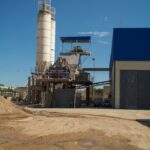Gender issues have recently become central to the expectations of financial institutions and development agencies. In the wake of reflections on human rights, analysing development projects around gender issues makes it possible to strengthen the consideration of women in the design and territorial insertion of a project assisting local development.
In this context, Ksapa has published a briefing paper sharing its work and methodological approach to ensure the solid integration of gender in the framework of infrastructure development. This paper shares feedback on the application of the Ksapa approach to a dam construction project in Africa. Each time, concrete projects allow us to learn several lessons and to continue to provide answers to the following question: how can we advance the issue of women in the development of large infrastructure?
1. “Integration of gender issues” : what does it mean?
Definition of gender
Gender, as defined by UN Women, refers to the socio-cultural construction of male and female roles and relationships. While “sex” refers to biological characteristics, being born male or female, gender describes culturally assimilated and instilled social functions.
Member States universally agree on the gender equality and women empowerment mandate. It encompasses all areas of peace, development and human rights. The mandates on gender equality derive from the United Nations Charter, which unequivocally reaffirmed the equal rights of men and women. Other international charters include a similar mandate, notably the African Charter on Human and Peoples’ Rights of 1981. It recalls in its article 18 that “the State has the duty to ensure the elimination of all discrimination against women and to ensure the protection of the rights of women and the child as stipulated in international declarations and conventions“.
Gender mainstreaming from a development perspective
The agreed conclusions of ECOSOC (1997) defined gender mainstreaming as: “The process of assessing the implications for women and men of any planned action, including legislation, policies or programmes, in all areas and at all levels. It is a strategy for making women’s as well as men’s concerns and experiences an integral dimension of the design, implementation, monitoring, and evaluation of policies and programmes in all political, economic and societal spheres. This ensures that women and men benefit equally and inequality is not perpetuated. The ultimate goal is to achieve gender equality.”
As such, gender equality is the overarching and long-term development goal. Meanwhile, gender mainstreaming is a set of specific, strategic approaches as well as technical and institutional processes adopted to achieve that goal. Gender mainstreaming integrates gender equality in national public and private organizations, in central or local policies, and in services and sectoral programmes. In the long run, it aims to transform discriminatory social institutions, laws, cultural norms and community practices, such as those limiting women’s access to property rights or restricting their access to public space.
2. A framework still in development
Expectations in a less standardised framework
Gender issues have recently become central to the expectations of financial institutions and development agencies. The socio-environmental clauses that condition financing opportunities incorporate the need to pay specific attention to gender. Does the project have an impact on the relationship between men and women? If so, how? How can the project be a source of opportunities for gender relations in the territory?
But the gender issue is still poorly covered by international reference frameworks. Gender management is not included in the International Finance Corporation (IFC) performance standards, for example. This can be explained, among other things, by the complexity of the subject, with situations often very different depending on the location, each with its own challenges.
The first approaches to reducing gaps
The World Bank has nevertheless initiated a first work on this issue. It introduces a conceptual framework that aims to address four key objectives for the promotion of gender equality and for overcoming the opportunity gaps between men and women in all territories and projects:
- Improving human endowment gaps. Reduce health, education and social-protection gaps between men and women.
- Removing constraints for more and better jobs. Increase women’s participation in the labor force, enhance income-earning opportunities, and improve access to key productive assets.
- Removing barriers to women’s ownership and control of assets. Improve women’s access to land, housing and technology.
- Enhancing women’s voice and agency and engaging men and boys. Include women in decision making on service delivery; reduce gender-based violence and its impact in conflict situations.
International organisations regularly share good practices from projects financed in several types of sectors. These make it possible to identify specific considerations for the issues at stake in a given project.
With these elements in mind, Ksapa had the opportunity to develop a gender action plan in the context of the construction of a dam in an emerging country. The projet led to the displacement of certain populations, affecting both their homes and their agricultural land.
3. Gender as a criterion of vulnerability
Despite a robust institutional framework, being a woman in many territories remains a barrier. This is especially true in more remote territories. Generally, customary law predominates over national law, penalising women who do not benefit from public benefits.
In general, and particularly in the region where Ksapa worked, the female population remains the most deprived. They experience particular difficulties recognised by international organisations and national bodies. Indeed, women over 16 years of age, due to their traditional role in society, their responsibilities within their households, their lack of secure access to land, their high representation in informal activities, etc., present specific vulnerabilities that could make them less able to resist or adapt to the impacts of the resettlement planned by the project. Even more so, households with no social safety net are the women with dependent children affected by the dam project.
4. Access to land, more difficult for women than men
A simple illustration of inequality through the use of customary law is access to land and access to property. National law provides for equal access to land for both men and women. But customary law implies that in the context of population displacement or inheritance, it is not women (mothers, wives, sisters, daughters) but men (fathers, husbands, brothers, sons) who should have priority to benefit from these new titles.
How can this issue be addressed in the context of resettlement of populations with food-producing activities? Here are a few illustrative examples of actions taken in the resettlement plan:
- Organise the census mission well. Ensuring to properly register who holds the property rights and who is in charge of the agricultural activity (often, the woman is in charge of the cropping activities for example);
- Organise specific consultations for women and men. This allows both groups to discuss freely their concerns about future resettlement;
- Ensure that the men and women impacted by this project have legal documents. If not, offer specific support (socio-legal assistance);
- Organise a move (in this case of resettlement) properly. Women and children should be able to continue their activities without being excessively affected by the move. This means aligning with the school calendar, providing specific assistance etc.
5. Women, an asset for territorial development
Some stakeholders do not understand why some actions are specifically dedicated to women. They would suggest to more generally identify all vulnerable populations (young people, senior citizens, people with disabilities…), including women.
We must therefore demonstrate that paying special attention to women can bring systemic benefits, with a territorial trickle-down effect that goes well beyond them.
The dam project was an opportunity to strengthen the rural sector. Relevant stakeholders (through a public and private partnership) built a skills development program that included a specific plan for women. In areas where women are heavily dependent on their husbands’ income, they have been able to develop their own activity, which has led to a diversification of income within the same household, with positive impacts on topics such as: access to education, access to health, etc.
Conclusion
Of course, the examples presented here are those identified in the context of the construction of a dam in a predominantly agricultural region, far from large agglomerations. The issues can vary depending on the project and the location.
But the objective remains the same. Without concerted efforts to take women’s needs into account, we can miss critical issues that make all the difference in the territories. We can lose an opportunity for a public windfall to ensure that it has positive spin-offs that take into account… 50% of the local population!
Sona is a Consultant for the Advise team at Ksapa.
She graduate in international development from Sciences Po Paris, and has worked on sustainable models within a diverse number of industries. Previously based in Kuala Lumpur, Sona has also tackled social and societal issues for Total and the Galeries Lafayette Group and has analyzed the implementation of the Chinese carbon market from Beijing. Her experience in different markets have helped her use a global approach when building a sustainable performance.




